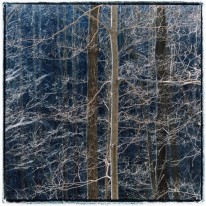Visual Rythms in Natural Forms
April 17, 2013
 I came to know the natural world initially through the encouragement of my parents, who both claim nature-friendly family traditions. When my parents, brother, and I moved to the countryside outside Charlottesville, Virginia in the late 1960s, we had no immediate neighbors and walked to our friends’ houses through the woods. We rock-hopped creeks, kept half-an-eye out for snakes, carried sticks to (respectfully) relocate spider webs that seemed always to span the trail at face level, and learned many of the native plants and trees. My mother, in particular, ensured that our vacations included natural areas, and we made many visits to the mountains of western North Carolina, home to most of her family. By the time I was in high school, our family moved to a forested mountainside facing the Blue Ridge Mountains where my parents still live today, and where I often visit and make photographs.
I came to know the natural world initially through the encouragement of my parents, who both claim nature-friendly family traditions. When my parents, brother, and I moved to the countryside outside Charlottesville, Virginia in the late 1960s, we had no immediate neighbors and walked to our friends’ houses through the woods. We rock-hopped creeks, kept half-an-eye out for snakes, carried sticks to (respectfully) relocate spider webs that seemed always to span the trail at face level, and learned many of the native plants and trees. My mother, in particular, ensured that our vacations included natural areas, and we made many visits to the mountains of western North Carolina, home to most of her family. By the time I was in high school, our family moved to a forested mountainside facing the Blue Ridge Mountains where my parents still live today, and where I often visit and make photographs.
I suspect growing up in the Great Eastern Forest (or more accurately, in its fragmented remains) has helped to shape my vision by forcing me to focus more intimately to express the essence of the biologically more complex but geologically less dramatic landscape of the Southeastern US. Unlike in a grand western vista, the view of a waterfall on a mountainside in the East is likely obscured by hundreds of species of trees, shrubs, vines, and other plants that surround both the falls and the photographer. It seems a natural progression to focus closer in on just the trees themselves, or even on particular branches and leaves — there are so many different, interesting shapes! Another incentive for close-in framing comes from avoiding urban power lines (and the pruning malformations near them), which limit the field of view to the extent that one is fairly forced into the abstract in order to visually make sense of the few remaining purely organic areas.
All life forms are created as the math of the universe endures our planet’s trials of hot, cold, sun, shade, water, drought, and time to achieve the function of surviving. Every species of tree or plant has a distinctly different look, leaf shape, or angle at which twigs or leaves emerge from branches, and all is choreographed for enduring and prospering. And each life’s form is shaped in part by the shapes of all the others. The shape and color of flowers are influenced by the shapes of the insects that pollinate them, and vice versa. Did plants become trees by outracing dinosaur appetites or each other’s need for light? Even the unique success of humanity, an anthropologist might say, comes from our hands with those convenient opposable thumbs that spurred on our minds which grew big inventing new things to do with our hands — and it is the trees that gave us our hands. When your hand falls by your side, even at rest your fingers will instinctively defy gravity to grasp an ancient limb.
I am always aiming for the point at which design and meaning intersect seamlessly. Finding the visual rhythms in natural forms is a way of gaining a glimpse of the greater design we can barely perceive — that we don’t have words for — that connects us all. I feel that my strength as a photographer is not so much in creating something new, but in noticing how things are.
– Kathryn Kolb